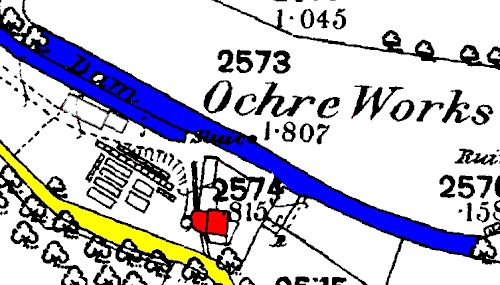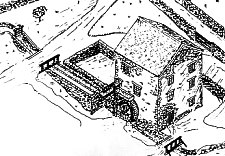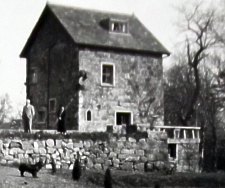(71) Ochre & Umber Mill - originally Ballasalla Flax Mill

From 1868 O/S XVI/8 - SC 278707
|

suggested view of flax mill as built

1937 restoration as a private dwelling
the couple are
standing on the old race -
the wheel would be where the door now is;
the small window would have allowed control of the sluice by the miller
|
John Quayle, clerk of the rolls, built this mill on the Silverburn, a little
downstream of the Creg Mill which he had acquired from
the Prestons some years earlier, in the early 1760s but did not at the time
acquire the Lord's licence for a new Mill - possibly his absence in London on
the Lord's business, the death of the 2nd Duke of Atholl, the transfer of the
Lordship to the 3rd Duke, followed quickly by the revestment might explain this
absence. It is likely that it was built a short time before the revestment in
1765. Post-revestment he, along with Dan Mylrea, had been appointed by the 3rd
Duke as stewards of his manorial estate. The governor no longer played any role
in granting licences thus Quayle could in effect
licence himself and others who had built or adapted mills to exploit the
large expansion in linen manufacture - an annual 1s rent - a smaller rent than
that given in the past for little or vertical mills. There was however a significant
disagreement when the 4th Duke began to take an interest in his Manx estate
- he accused Quayle of dishonesty in building his own estate at the expense
of the Duke.
The mill remained in the Quayle family for the next century though the flax
scutching had ceased by the 1830s as George Quayle advertised for a new tenant:
Manks Advertiser, Tuesday, 17th April 1832
WOOL CARDING MILL.
TO be SOLD, hy .Private Contract, or LET, from and after the 12th November
next,—The MILL a short distance lower down the River than the Creg Mill,
in Malew, formerly a Flax Mill, but now in the occupation of ROBERT MULON.
as a Wool Carding Mill. The Land attached to the Mill is 2A. 2R. 23p. Further
Particulars may be known by applying to the Proprietor, G. QUAYLE , Castletown.
13th April, 1832. (16)
The previous tenant, Robert Mullin had moved to a larger
mill -
Lamplugh gives some history of
the extraction and preparation of Ochre and Umber which around 1830 would appear
to have gained some impetus by the entry of James Grellier who acquired the
lease originally given by the Duke to a Thomas Satterwaite. Grellier, an ex-army
surgeon from London, already had something
of a reputation as a sharp operator, apparently dug and exported significant
quantities by 1835 for James McCrone, by then Crown agent to ask
the acting Attorney-General to begin legal proceedings to obtain both information
on quantity and payment of the Lordship due. Grellier was an intimate
friend of Edward Forbes, the banker, and it is possible that some of the
capital needed to modify a flax mill into a processing mill for Ochre originated
from Forbes - the later collapse of this bank in 1843 caused significant financial
damage to many.
Grellier was involved in many commercial undertakings, usually in partnership
with Edward Forbes - some light is thrown on this nexus by a law case in the
Chancery Court in July 1841 [reported at length in Mona's Herald 20 July
1841] in which Peter Crank Woods sued Edward Forbes and Adolphus M'William the
remaining partners of several companies in which Grelier had also been a partner.
One was as woollen manufacturers when James Grellier & Co operated the Union
Mills along with the firm known as P.C Woods & Co as Corn merchants.
Another company also called James Grellier & Co which consisted of Grellier
and Forbes as partners in a mining and ochre business which operated from about
1832 and that around 1837 Forbes bought out Grellier's share in the Ochre business
though the company still traded as James Grellier & Co and that partnership
was never dissolved though run entirely by Forbes.
Thus in 1837 Pigot's directory which noting that "Not far from Ballasalla
are extensive limeworks, and an ochre and umber manufactory" also has:
Grellier Jas. & Co. umber & ochre manufacturers, Ballasalla —
Thos. Pearson, agnt
Thomas Pearson can be found in 1841 census as an English born (as were all
the household) mines agent at Ballasalla Lodge north of Ballasalla and close
to the Mill, at Flax Mill house, the adjacent cottage also built by Quayle,
was Wm Creer agricultural labourer.
As this company was actually owned by Edward Forbes whose bank failed in 1843
the lease on the mill was it seems transferred to Gavin Torrance as in Slater's
1846 directory:
Torrance G.& Co. Ballasalla; North quay, and Duke street, Douglas Joseph
Torrance, agent, Ballasalla;
Torrance was still there in 1857 with
Muncaster Thomas, manager of the umber and ochre works, Ballasalla
and in 1863 Thwaite's directory
Torrance G. & Co., manufacturers of umber, ochre, and cement, Ballasalla
The 1868 O/S plan would appear to indicate an extension at the side of the
Mill - possibly this was a grinder coupled to the water wheel on the west side
of the 1765 mill building - the plan also shows the settling tanks mentioned
by Lamplugh used in the processing of the mined material.
The Mill would appear to have passed to the Quine family, possibly at the time
Wm Quine obtained the Creg mill in the early 1860s; Teddy
Blackburn writing in 1989 recounts Dr Robert Quine retiring to the Island
and converting the mill into a 'lovely dwelling house' - he also notes the Umber
House on the Irish Quay at Castletown where the umber was stored prior to export
off the island. This trade had ceased pre WW1, the Umber House itself being
demolished in the 1950's. This Umber house, I think, had been built as Ordnance
stores for the garrison stationed at Castletown and had briefly been transformed
into Barracks but was sold after the new Barracks on the Parade were completed
in 1834. A little more detail had been
given earlier by C. E. Watterson.
The remaining building is known as the Umber House, for the following reason.
It was used by a Mr. Torrance, a ship's chandler and provision dealer, who
carried on his business at the Fleetwood Corner on the North Quay at Douglas,
as a store for umber. Mr.Torrance had his works near Ballasalla, at a water-mill
near Silverburn, which has now been altered and with additions thereto is
used as a residence by Dr. Quine. The umber was periodically shipped in barrels
to an English port in Mr. Torrance's schooners - the 'Christianna' and the
'Bessy' - the latter schooner making the journey once a year to Lisbon to
load cork for the fishing nets.



